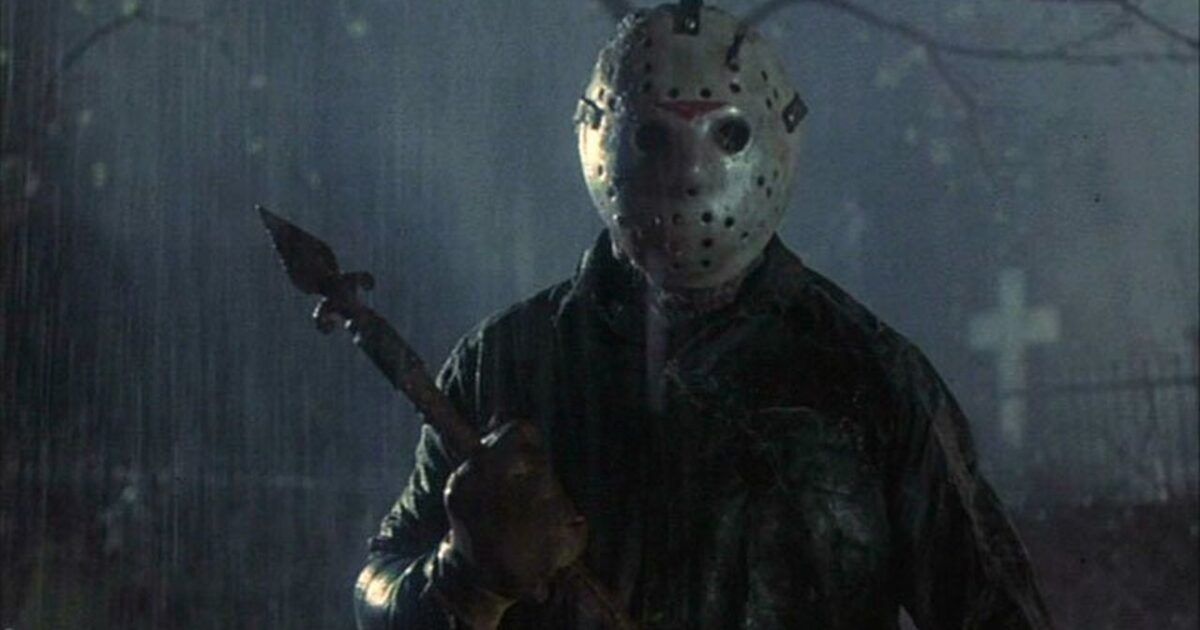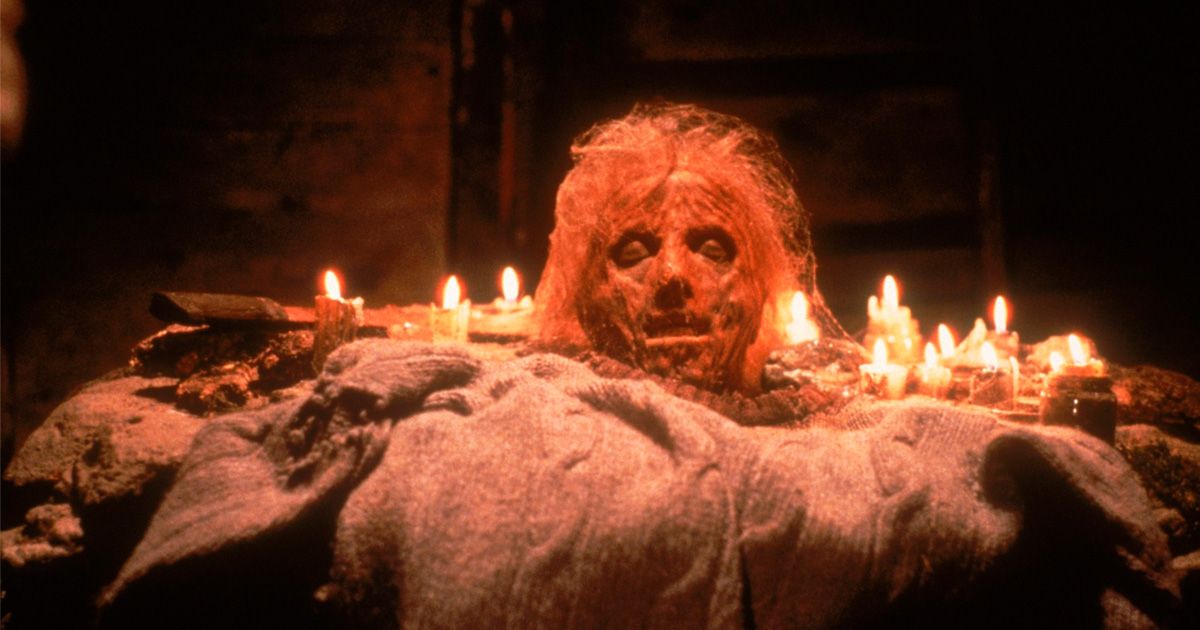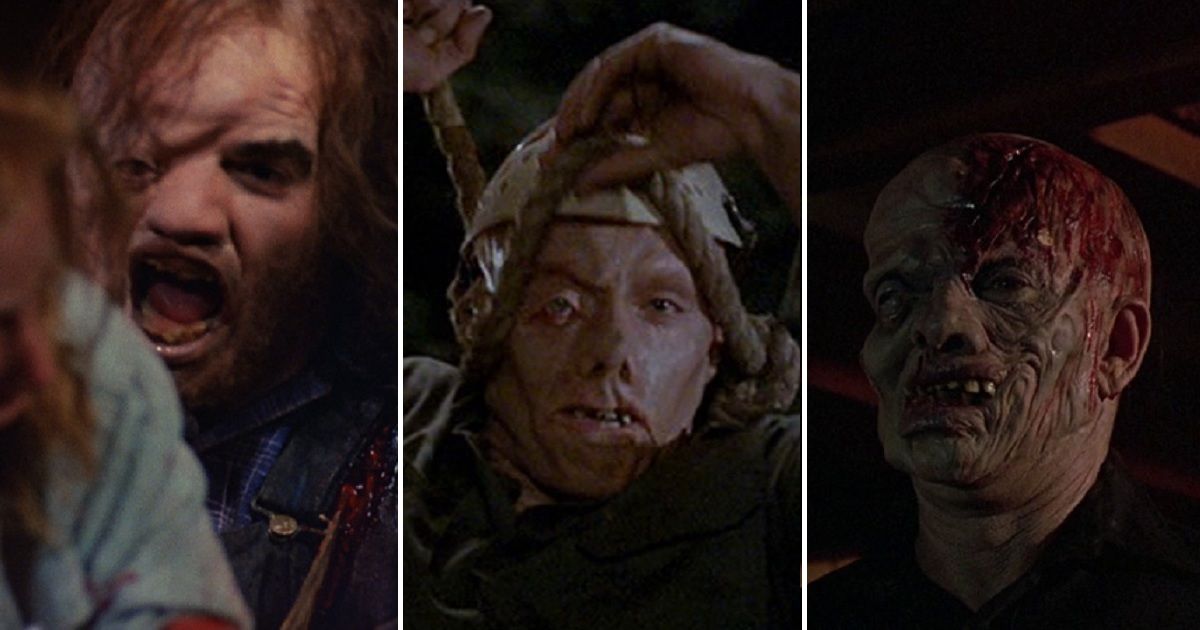During the first act of Friday the 13th Part 2, after the counselor trainees have all been introduced, Paul Holt, the manager of the camp, tells the ghost story of Jason by a campfire. Paul says, “I don’t want to scare anyone, but I’m going to give it to you straight about Jason. His body was never recovered from the lake after he drowned. And if you listen to the old timers in town, they’ll tell you he’s still out there – some sort of demented creature, surviving in the wilderness, full-grown by now. Stalking, stealing what he needs, living off wild animals and vegetation. Some folks claim they’ve even seen him right in this area. The girl who survived that night at Camp Blood, that Friday the 13th, she claimed she saw him.
She disappeared two months later. Vanished. Blood was everywhere. No one knows what happened to her. Legend has it that Jason saw his mother beheaded that night, and he took his revenge. A revenge that he’ll continue to seek if anyone ever enters his wilderness again. And by now, I guess you all know, we’re the first to return here. Five years – five long years, he’s been dormant, and he’s hungry. Jason’s out there, watching, always on the prowl for intruders. Waiting to kill, waiting to devour. “Thirsty for young blood.”
Hit the pause button on the VCR, folks. This is where the whole franchise takes a turn toward deceit after the shocking twist at the end of the first film. What we are being introduced to here is the internal mythology of the franchise. This is a red herring. In what world does an 11-year-old boy successfully rough it through a single winter in the woods in New Jersey? Being an adult and trying to be an island unto oneself off in the woods tends to end in starvation. Being 11, barefoot in a pair of swim shorts, without any weapons to hunt, no shelter, no fire starter kit, no filtered water – it just is not happening.
The First Movie’s Twist
Many kids in the late ’80s and through the ’90s were first introduced to Friday the 13th through the sequels and the imagery of the goalie mask-wearing killer. It is a franchise that many of the generation of Nintendo and VHS saw the sequels before the first film. Upon viewing the original Friday the 13th, xennials were shocked to find that Jason is not the killer. It is his mother, Pamela Voorhees. And why would you suspect it is not a man at all? Through the whole movie, when we see the killer’s hands enter the frame, from a first-person perspective, they are a man’s hands.
The audience is not even suspecting a woman is the killer (or one of the killers) when they see Pamela step out of the jeep at the end. Clearly, the power shown by the killer could only have been performed by a man: pushing an arrow through a mattress and then through the throat of Kevin Bacon on top of it, and throwing the body of one of the female counselors through a window like she was a football. The audience’s brains are subconsciously expecting a man, so, no matter if you watched the first movie first, the reveal is a twist. But if the theory below is to be followed, your brain was not wrong, and your eyes did not lie to you; you did see a man’s hands.
Jason Goes to Fridge Logic
After Alice decapitates Pamela at the end of Friday the 13th, she gets in a boat and paddles out into the lake. In the morning, when the police arrive at the camp, the undead corpse/ghost of Jason leaps from the water and attempts to drown Alice. If Jason faked his own drowning as Paul’s ghost story suggests in Part 2, who comes out of the water at the end of the first movie? For decades, the seeming resurrection of Jason after the first movie has confused fans. After Part 8, New Line Cinema acquired the rights to the characters and created Jason Goes to Hell. In this 9th film, the idea is introduced that Jason is actually a demon worm, and he was reborn through his mother’s body after she was decapitated in the first movie. It is a ridiculous change, and Friday the 13th fans will not put up a fight if you argue Jason Goes to Hell is not part of the original continuity any more than Jason X or the 2009 reboot.
The plot hole was never correctly addressed in the first eight movies distributed by Paramount. The further the franchise got into the sequels, the more the question begged to be answered. How did Jason drown in 1957 and come back from the dead as an adult man in Part 2? What if for over 40 years, fans have been accepting the internal mythology of Crystal Lake, but it is just that, a myth. We know Jason did not survive his drowning. That forces the question: who is the killer in the sequels, if not Jason?
Sins of the Father
The simplest answer is often the right answer. The simplest answer that resolves the continuity error of Jason’s death is that a living man is the lone killer in Friday the 13th Part 2-4, and he is Jason’s father, Elias Voorhees. Elias is the missing piece of this family, but he has been there the whole time. The sequels are the work of a husband, continuing the revenge that he and his wife began in the first film and cutting down everyone in the area of Crystal Lake.
You are saying to yourself, but we see the killer’s face unmasked in Part 2. One possible reason for the killer’s appearance being similar to Jason’s is that Jason’s facial features were inherited. We only need to make the jump that Pamela and Elias had some kind of sexual relationship. The circumstances of their union is not covered in the films. It may have been a loving relationship that grew in spite of Elias’ unique condition. Pamela may have pursued Elias for his isolation and to take advantage of him because she so desired a child and had been denied one.
Or Jason might have been conceived from a sexual assault. In Part 3, Chris Higgins tells her boyfriend, Rick, about when she encountered Jason Elias in the woods of Crystal Lake. The flashback implies that she was sexually assaulted. This would demonstrate a pattern of behavior with Elias to support the theory he assaulted Pamela. But there is a competing theory, and most of the evidence in the films points to this second explanation being the truth.
The Mask Theory
The second explanation for the killer’s likeness to Jason is that Elias created masks to perpetuate the myth of Jason’s survival or return from the dead. It may seem like the more complex explanation, but it is the more mundane, realistic explanation. Between Part 2 and Part 3, the killer’s features shift. He is suddenly clean-shaved and bald. In Part 3, two different Jason masks designs are used. One of the masks used in Part 3 looks like a sinister monster with symmetrical eyes and a scowled expression, and is seen clearly in images of the alternate ending. The second mask in Part 3 has asymmetrical eyes, like in Part 2. Elias has multiple masks, explaining the errors in Part 3.
Part 2 presents the strongest argument that Elias wears a mask in its cold open. The sequel opens with a male killer walking down a suburb sidewalk at night, who then invades the home of the survivor of the first film, Alice, and kills her with an ice pick. This means the killer is intelligent enough to track Alice down, is able to access such information to begin with, drive to her location (implying he has a car and driver’s license), navigate the suburb without standing out (meaning he does not look like the brother of Sloth from The Goonies) and is able to escape the town, with the body and without attracting attention in the window between the murder and the discovery that Alice is missing and there is blood all over the kitchen (again, suggesting he has a car).
The franchise broadcast the mask secret in Part 4: The Final Chapter with the introduction of a child named Tommy Jarvis who is a hobbyist mask builder. This subplot is waving it in your face that you cannot trust your eyes. Movie magic is not limited to movie sets. Part 4 is subliminally telling the audience that the killer is wearing a mask. You already accept that such a mask is believable. You wait the whole movie to see the mask. It only stops short of showing you that the mask is a mask within the movie.
The next sequel would fully deconstruct the assumption that Jason was the killer in Part 2-4. In Part 5: A New Beginning, a paramedic dresses as Jason and uses his identity as cover for a revenge murder spree. The plot of the copycat killer is spilling the beans. If the paramedic can do this, why should we believe what we saw in the previous three sequels? The plot of Part 5 is the plot of the franchise — that people accept the ghost story of Jason without questioning it.
In Part 6: Jason Lives, Tommy Jarvis returns again to dig up and burn the body of the killer he dispatched in Part 4. When he and his friend uncover the body, we see the killer’s eye sockets are symmetrical. The flesh has decomposed over the time-jump between movies, and so has the foam latex mask that Elias wore. The body is struck by lightning and reanimated like Frankenstein’s monster, and in Part 6-8, the ghoul continues to be credited as Jason. In all three of these last movies in the Paramount continuity, the undead killer’s skull structure is symmetrical.
In Part 8, the movie is mostly set on a boat carrying a class of high school graduates on their senior trip. The ghost of the 11-year-old Jason appears to the lead, Rennie Wickham, separate from the zombie goalie who is stalking the boat the graduates are traveling on. This is the only time after the first movie in the original continuity where we see the ghost of the child-Jason.
This story originally appeared on Movieweb




